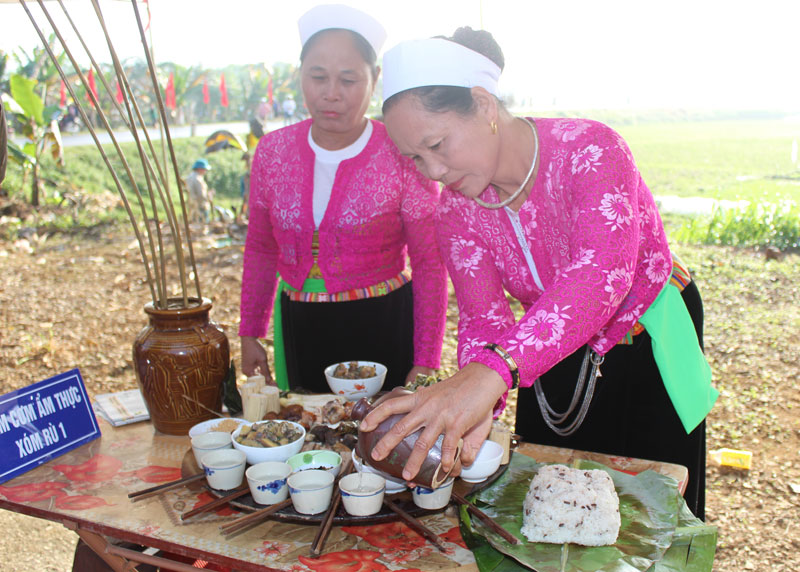
(HBO) – Despite changes in their modern life, an increasing number of Muong ethnic women seek their ways back to their old days by wearing traditional dresses to celebrate lunar New Year (Tet) instead of modern outfits.

Muong Dong ethnic women in
Kim Boi district in traditional costumes prepare a tray of their signature
dishes.
In an interview with
reporters from the Hoa Binh Newspaper, Bui Thi Hao from Chanh hamlet in Vinh
Dong commune said with delight that in her village, elderlies wear Muong costumes
every day while younger women prefer Muong dresses for the occasions of
festivals, ceremonies, and weddings.
According to her, all
women in her village own at least one traditional dress and a silver chain belt,
passed down as a special keepsake among women in their families for
generations.
A traditional Muong dress
consists of a white shirt and long black skirt. The outfit, which is suitable
for different body sizes, keeps its wearer comfortable in the cool weather in spring
but is still elegant enough. Nowadays, the shirt has more colours than just
white due to local women’s preferences.
Life is changing. Muong
people’s stilt houses have been replaced with cement ones, and parts of their
language and traditions modified. However, their costume embodies a strong
power to survive and even thrive in the modern life./.
Gongs hold a special place in the cultural and spiritual life of the Muong ethnic people in Hoa Binh province. More than musical instruments, they are an indispensable part of community rituals and collective memory, echoing through generations as a spiritual thread linking the past, present, and future.
Preserving and promoting the cultural values of the Muong ethnic group has become an urgent task in the current context, as many traditional values face the risk of fading away. This effort requires not only protecting the cultural identity but also eliminating outdated customs and developing a modern cultural lifestyle, contributing to sustainable values for the Muong community in Hoa Binh province.
The Muong ethnic culture, deeply rooted in Vietnam’s mountainous north, continues to be preserved and revitalised by dedicated individuals and communities determined to safeguard their ancestral identity.
The Muong group is one of the largest ethnic minorities in Vietnam, primarily found in Hoa Binh province. The Muong people in Hoa Binh boast a rich and diverse cultural treasure that reflects the unique identity of this ethnic group. Accounting for over 63% of the province's population, they have created and preserved numerous distinctive cultural values, contributing to their unique identity. Their cultural heritage is an invaluable asset, at the heart of their national identity, and represents a vibrant spiritual life that must be preserved and promoted in today’s modern world.
For generations, the ethnic communities of Hoa Binh province, particularly the Muong people, have preserved vibrant festivals deeply intertwined with the region’s geography, nature, and social traditions. These celebrations enrich Hoa Binh’s spiritual life and cultural identity, reflecting both folk beliefs and the intermingling of ethnic customs. Many of these festivals have endured the test of time, passed down through generations and continuing to thrive today. Among them, the Khai Ha (Going Down to the Field) festival stands out as one of the most significant events of the Muong ethnic group.
Muong calendar, known as sach doi, is an ancient folk knowledge system developed through observations of the movement of the pleiades star. This unique calendar consists of 12 bamboo sticks, each representing a lunar month. Specific days within each month are marked with distinct symbols, guiding locals in determining auspicious and inauspicious days for important activities.



